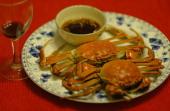 | What are the main ingredients used in Shandong Cuisine? Shandong is a large peninsula surrounded by the sea, with the Yellow River meandering through the center. As a result, seafood is a major component of the cuisine. The most famous dish is the sweet and sour carp. Beyond the use of seafood, Shandong is somewhat unique for its wide use of corn, a local cash crop, which is chewy and starchy,often with a grassy aroma. |
It is often served simply as steamed or boiled cobs, or removed from the cob and lightly fried.
Shandong is also well known for its peanut crops, which are fragrant and naturally sweet. It is common at meals in Shandong, both formal and casual, to see large platters of peanuts, either roasted in the shell, or shelled and stir-fried with salt. Peanuts are also served raw in a number of cold dishes that hail from the region. The wide use of a variety of small grains distinguishes Shandong cuisine from most of China's other culinary traditions in. Millet, wheat, oat and barley can be found in the local diet, often eaten as porridge, or milled and cooked into one of the many varieties of steamed, baked and fried breads or buns, pancakes, crisp cakes, and big cakes stuffed with minced meats. |